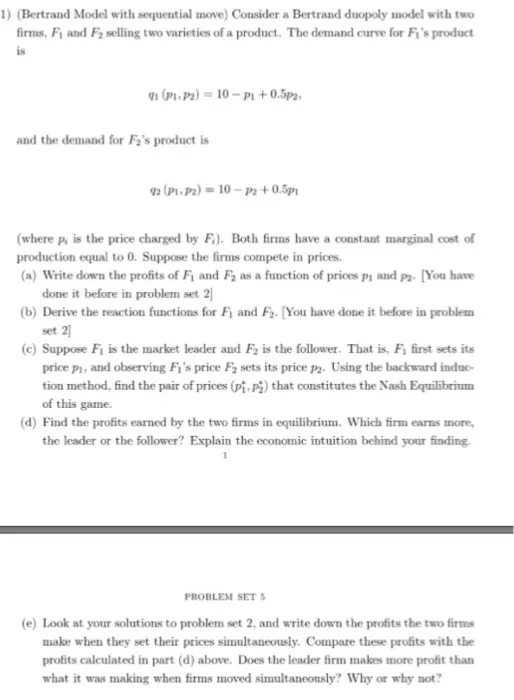Answered step by step
Verified Expert Solution
Question
1 Approved Answer
1) (Bertrand Model with sequential move) Consider a Bertrand duopoly model with two firms, F and F selling two varieties of a product. The

1) (Bertrand Model with sequential move) Consider a Bertrand duopoly model with two firms, F and F selling two varieties of a product. The demand curve for Fi's product is 91 (P1-P2) = 10-P1 +0.5p2, and the demand for F's product is 92 (P-P2) = 10-P2+0.5p (where p, is the price charged by F). Both firms have a constant marginal cost of production equal to 0. Suppose the firms compete in prices. (a) Write down the profits of F and F2 as a function of prices py and p2. [You have done it before in problem set 2] (b) Derive the reaction functions for F and F. [You have done it before in problem set 2] (c) Suppose Fi is the market leader and F2 is the follower. That is, F first sets its price pi, and observing F's price F sets its price p2. Using the backward induc- tion method, find the pair of prices (p. p) that constitutes the Nash Equilibrium of this game. (d) Find the profits earned by the two firms in equilibrium. Which firm earns more, the leader or the follower? Explain the economic intuition behind your finding. PROBLEM SET 5 (e) Look at your solutions to problem set 2, and write down the profits the two firms make when they set their prices simultaneously. Compare these profits with the profits calculated in part (d) above. Does the leader firm makes more profit than what it was making when firms moved simultaneously? Why or why not?
Step by Step Solution
★★★★★
3.42 Rating (165 Votes )
There are 3 Steps involved in it
Step: 1
a The profits of firm 1 and firm 2 as a function of prices p1 and p2 are given by Profit of firm 1 1...
Get Instant Access to Expert-Tailored Solutions
See step-by-step solutions with expert insights and AI powered tools for academic success
Step: 2

Step: 3

Ace Your Homework with AI
Get the answers you need in no time with our AI-driven, step-by-step assistance
Get Started


